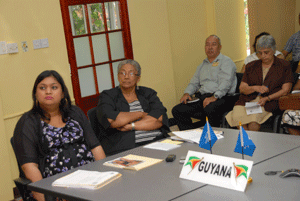THE community-based School Feeding Programme (SFP) in Guyana has generally been well received in most communities in which it has been implemented, resulting in increases in school attendance, nutritional improvement, and better grades in English and Mathematics.  A survey carried out in the relatively recent past revealed these results, which were released last week at the Office of the World Bank on Carmichael Street, Georgetown.
A survey carried out in the relatively recent past revealed these results, which were released last week at the Office of the World Bank on Carmichael Street, Georgetown.
This feeding programme is a component of the Education For All – Fast Track Initiative (EFA-FTI) which Guyana has been implementing for over eight years, under which the Education Ministry has undertaken to upgrade the SFP in the hinterland.
Previously, children were provided with milk and biscuits, but those products presented quality, and consequently acceptability, challenges on arrival at remote destinations.
Under the SFP, participating schools are provided with $175 to provide a meal for each child enrolled and present at the school. This amount covers the cost of foodstuff being prepared, transportation, fuel to facilitate cooking, cleaning agents, cooks’ stipends, and any other expenditure associated with the activity.
Fifty schools were each provided with a sustainability grant of approximately $400,000 to engage in small agricultural projects (chicken rearing, pig rearing, gardening, etc) to aid in sustainability of the programme in the post EFA-FTI period.
To date, a total of 92 of the 138 primary schools in the hinterland are involved in the programme, which represents approximately 84 percent (16,000 of 19,000) of the target group.
Present at last Friday’s meeting were Education Minister, Priya Manickchand, EFA-FTI Coordinator, Edward Jarvis, and Chief Planning Officer, Evelyn Hamilton. World Bank Senior Education Specialist, Angela Demas and Consultant Christian Borja-Vega were also present via videoconferencing.
According to Borja-Vega, the challenges found in hinterland communities include unemployment, food insecurity, and limited access to basic services.
He, nevertheless, reported that the programme yielded positive results in terms of increased school attendance and behaviour.
The Body Mass Index (BMI) of children has improved between 7 and 34 standard deviations, and there have been academic and nutritional improvements.
He reported further that English scores have increased from 37 to 48 points; and Mathematics scores have recorded an 8.1-point increase, while Science and Social Studies have each recorded 4-point increases.
Minister Manickchand observed that the SFP has been one of the most successful initiatives; government very strongly supports it, and it has complemented government’s other school feeding initiatives.
Manickchand pointed out that, in 2011, government spent over $1B on the national and hinterland school feeding programmes in education, benefiting over 63,000 children. A similar sum has been allocated for school feeding during this year, she said.
According to her, the broader goal of EFA-FTI is to have the school and community working closer together for the improvement of children’s education.
“It is encouraging to note that this programme has yielded some positive results, and has been well received by most communities in which it is being implemented. Teachers have spoken about classroom performance, capacity enhancement at a community level.”
Manickchand said Government and the Education Ministry are very appreciative of the programme, as its impact on the attendance rate of children has been “extremely positive”. The highest rates of attendance have been recorded in Regions Eight (Potaro/Siparuni) and Nine (Upper Takutu/Upper Essequibo), she disclosed.
She praised the programme as being closely monitored and well-evaluated.
Asked to relate some of the actions taken by the Education Ministry since the survey, Jarvis reported that small sustainability projects were launched at 45 schools, based on proposals from the communities. These projects involved poultry rearing and school gardening among other initiatives, and a bit of training on diversified investment financing for equipping school kitchens was also done. There has also been follow-up training in accounting and management at schools.
Jarvis said the community-based school feeding programme targets 138 primary schools in Regions One (Barima/Waini), Seven (Cuyuni/Mazaruni), Eight and Nine. To date, 92 schools are providing school lunches on a daily basis, representing 67 percent of all hinterland primary schools.
However, in those schools, there are 16,303 children enrolled and are currently benefiting, and that represents 84 percent of the target population. The average annual cost is $610.5M, Jarvis reported.
World Bank survey shows SFP transforming school attendance & pupil performance –allocated $1B for 2012
SHARE THIS ARTICLE :
Facebook
Twitter
WhatsApp





.jpg)








